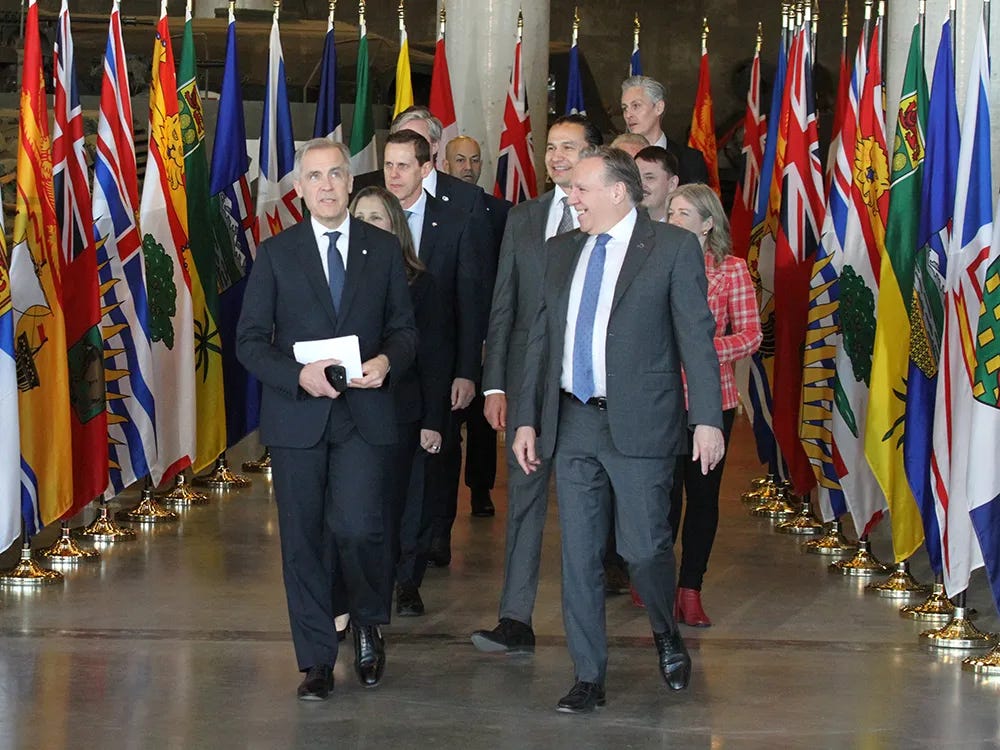Nation-Building will Take More than Talk
The prime minister is banking on an upswell of patriotism to bolster public support for large infrastructure projects — but it won’t be easy.

By Jacob Kates Rose
Just before last month’s election, Yves-François Blanchet told his supporters — in English, no less — that the Quebecois “are, whether we like it or not, part of an artificial country with very little meaning, called Canada.” While such a blunt assessment from the Bloc on Quebec’s standing within Canada should surprise no one, Blanchet referring to Canada as an artificial country during this particular election cycle was dissonant with the flag-waving patriotism currently in vogue across Canada, that permeated other parties’ campaigns and now the new Carney administration.
In supermarkets, on the news, and in ads on TV instructing us to keep our elbows up (ideally with a Molson in both hands), we are having a renaissance in Canadian patriotism. Prime Minister Carney is leaning in. During the leadership race he made a point of rejecting — without naming names — his predecessor's description of a “post-national” Canada. As PM, he’s renamed the post of Minister of Canadian Heritage to the new Minister of Canadian Culture and Identity. Where did all this patriotism come from? And could we potentially harness it for the good of the federation? One of the ways that the new prime minister wants to put that patriotism to work: Getting the provinces on board to deliver huge infrastructure upgrades that he is calling “nation-building projects.”
In everyday language, most people differentiate between patriotism and nationalism, and fewer people self-identify with the latter. Often, the hinge between one and the other is that patriots acknowledge their country’s past sins and nationalists deny them.
Political philosophers tend not to delineate the two phenomena in the same way, with greater concern for whether the individual identifies as part of a nation. Some scholars, including Joseph Heath, argue that there are no shared values in Canada, but only a shared commitment to living amongst a plurality of values. Others, like the influential scholar Benedict Anderson, insist that to have a nation, one must have an ‘imagined community’ in which members believe that they share a common culture with not only their immediate neighbours, but with all their compatriots.
Heath and Anderson might disagree about the definition and importance of a national identity, but I would wager that both would agree that Canadian identity is stronger today than it was six months ago. Indeed, the percentage of Canadians strongly identifying as such, and reporting pride in their Canadian identity, has been on a steady slide for 20 years, but that has switched dramatically since Donald Trump began disparaging the prime minister, the legitimacy and sovereignty of our country, and launched a trade war. Now, pride in the country has jumped to 67 per cent. Even in Quebec, the part of non-Indigenous Canadian society with the strongest claim on a unique national identity, Canadiana is on the rise.
150 years ago, an infrastructure project was so crucial to building Canada that it was called the National Dream. The pacific railway physically linked together the prairies, mountain west, and pacific coast. It was also a precondition for confederation on the part of British Columbia. But it was not without its costs: It inflamed relations with First Nations and sent the infant country deep into debt. But without the railway, Canada would never have developed as it has for the last 150 years.
With that history in mind, when Prime Minister Carney requested last month that each Premier submit a list of potential ‘nation-building’ projects ahead of a roundtable of First Ministers in Saskatoon in early June, you can be sure that the upwelling of civic patriotism is important to the present political calculus. Considering the price tag and the long years of investment before associated revenues start flowing, the PM is anticipating that patriotism can subsidize the increased capital expenditures required to build on this scale.
So far, Wab Kinew (Manitoba), Doug Ford (Ontario), David Eby (British Columbia) and Susan Holt (New Brunswick) have replied to the Prime Minister’s request. Wab Kinew’s letter is asking for upgrades to the Port of Churchill, investment in agricultural sciences, twinning the trans-Canada highway, expanding critical mineral access, and the creation of indigenous fair-trade zones. Doug Ford’s wish list includes critical minerals in the ring of fire, nuclear technology, a port on James Bay, a tunnel under the 401, and expanding and electrifying GO, Ontario’s regional rail service. Susan Holt wants upgrades at the Port of Saint John, a national electricity grid, development on internal trade barriers, increased prefabricated housing construction, more service members at CFB Gagetown, and (with the chorus) expanded critical mineral exploration. David Eby wrote about softwood lumber, improving trade corridors to bring more goods to Vancouver, expanding British Coumbia’s electrical grid up the coast, addressing housing prices, and (say it with me now) critical mineral exploration.
Will the surge in Canadian pride last long enough for any of these projects to see shovels hit the ground, let alone come online? Or will the challenges imposed by our federal system cause too much friction? Alberta seems headed for a independence referendum in 2026. Yves Francois Blanchet, fresh off his remarks on Canada’s artificiality, had this to say. “The first [step] is to define oneself as a nation, therefore it requires a culture. And I am not certain that oil and gas qualifies to define a culture.”
Jacob Kates Rose is a Toronto-raised student who has come to the Max Bell School to learn the skills to think about policy, society and government in an interdisciplinary, evidence driven manner. He has previous experience working at Toronto's City Hall, as well as in various capacities in community arts organizations. Jacob is passionate about immigration and multiculturalism, housing and land use policy, and the intersection between law, policy, government and society.





Excellent